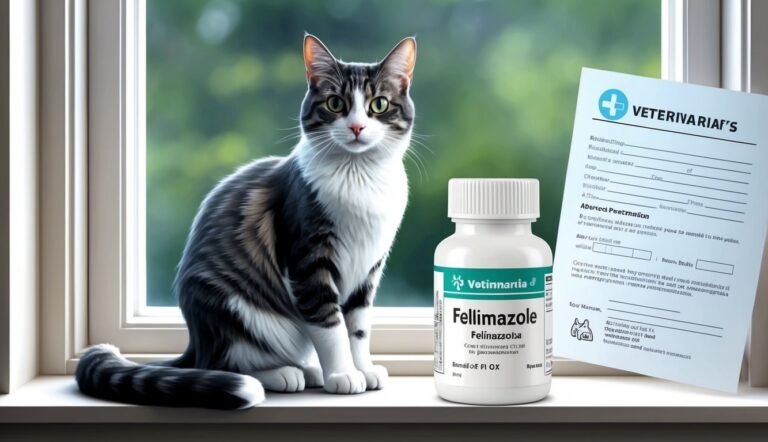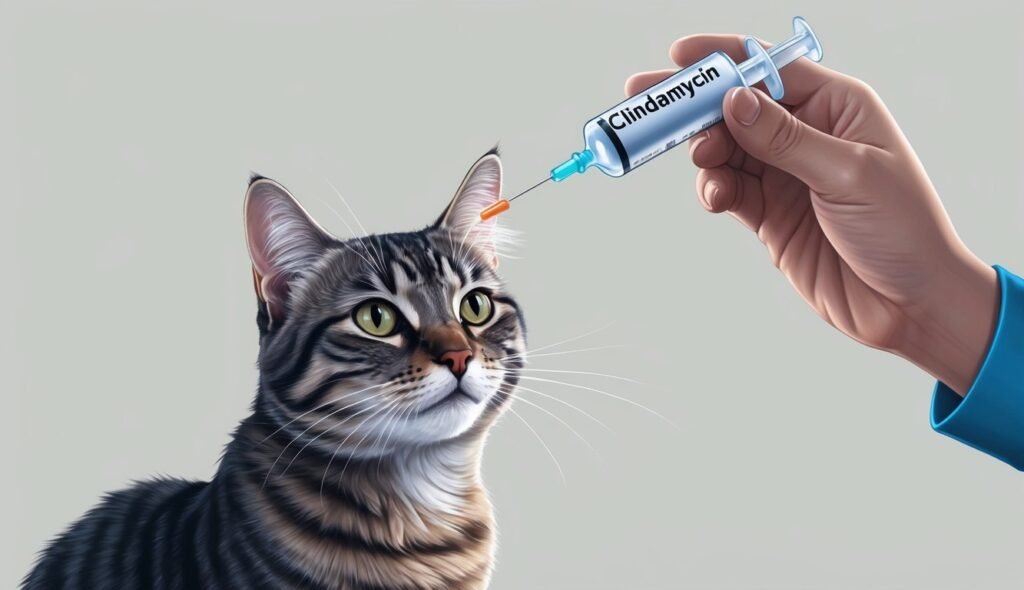Felimazole is a vital medication for managing hyperthyroidism in cats, a condition that can significantly impact your pet’s health.
This FDA-approved antithyroid medication, which contains methimazole, helps block the production of excess thyroid hormones.
This effectively alleviates symptoms associated with this common endocrine disorder.
Understanding how to properly use Felimazole can make a meaningful difference in your cat’s wellbeing.
When you notice signs like weight loss, increased appetite, or excessive thirst in your cat, it could be hyperthyroidism at play.
Getting a timely diagnosis and treatment can help reverse these effects and restore your cat’s quality of life.
With proper administration and monitoring, Felimazole can help your feline friend lead a happier, healthier life.
As a responsible pet owner, being informed about the medication and its potential side effects is essential for ensuring your cat’s safety.
This blog post aims to give you clear insights on Felimazole, dosage guidelines, how to observe your cat’s response to the treatment, and alternative options you might consider.
Key Takeaways
- Felimazole treats hyperthyroidism by blocking thyroid hormone production.
- Proper dosage and monitoring are crucial for your cat’s safety.
- Consult with your veterinarian for alternative treatments if necessary.
Understanding Hyperthyroidism in Cats
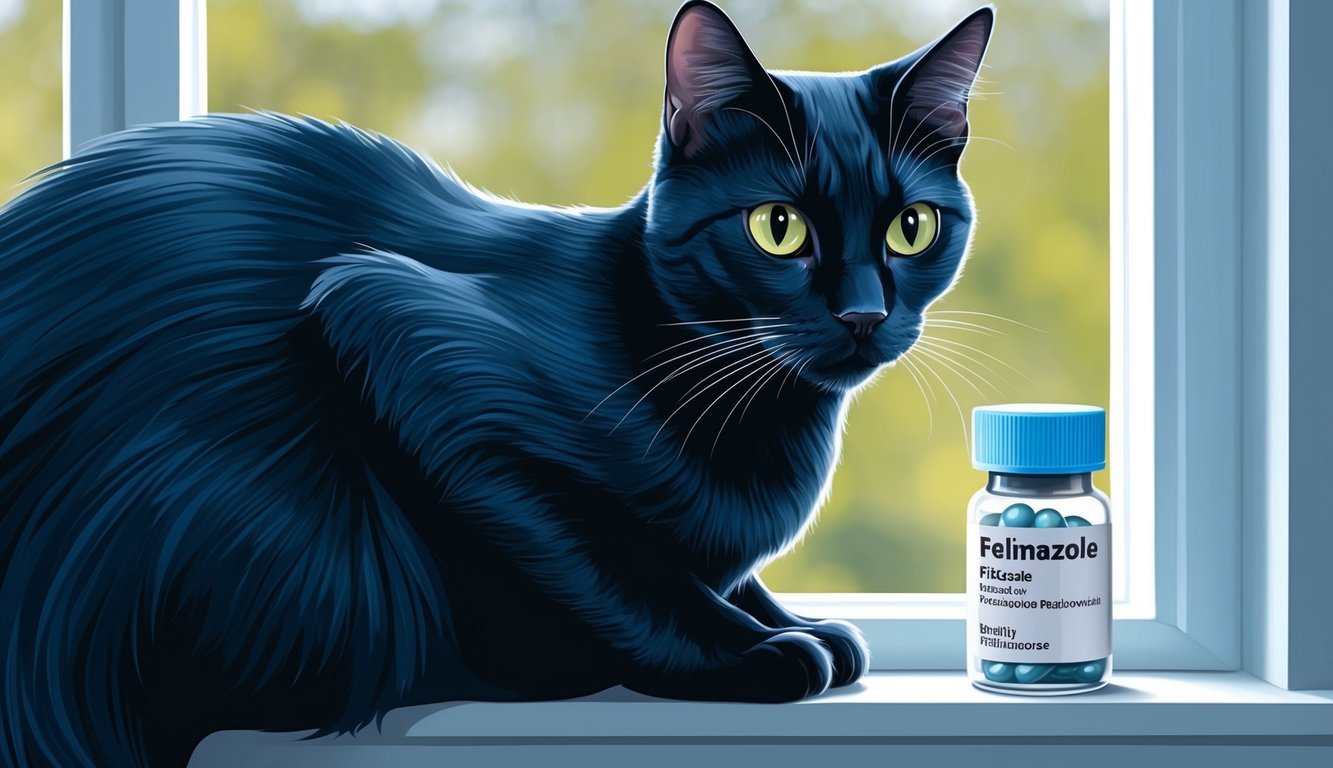
Hyperthyroidism is a common condition in older cats, primarily due to an overproduction of thyroid hormones.
These hormones, specifically T3 and T4, play a crucial role in regulating metabolism.
When the thyroid gland becomes overactive, it can lead to several noticeable symptoms and health issues.
What Is Hyperthyroidism?
Hyperthyroidism occurs when the thyroid gland produces excessive amounts of the hormones thyroxine (T4) and triiodothyronine (T3).
This condition is often caused by thyroid tumors or hyperplastic changes in the gland.
In cats, the thyroid gland is typically located in the neck area.
When overactive, it can stimulate the metabolism excessively, leading to various health complications.
This condition is quite prevalent in middle-aged to senior cats, with studies showing a higher incidence in certain breeds.
If left untreated, hyperthyroidism can negatively impact nearly all body systems, making it critical to recognize the signs early.
Signs of Hyperthyroidism in Cats
You may notice several symptoms if your cat has hyperthyroidism.
Common signs include:
- Weight Loss: Despite eating well, your cat may lose weight. This paradox occurs because the excess thyroid hormones cause the body to burn calories more rapidly.
- Increased Appetite: Alongside weight loss, your cat might display an insatiable hunger.
- Hyperactivity: Excess energy can lead to hyperactivity and restlessness.
- Vomiting and Diarrhea: Some cats experience gastrointestinal upset.
- Excessive Thirst and Urination: Increased thirst and more frequent urination often accompany this condition.
These signs can significantly affect your cat’s quality of life.
Observing any of these symptoms warrants a visit to your veterinarian for further evaluation.
Diagnosing Hyperthyroidism
To diagnose hyperthyroidism, your veterinarian will start with a thorough physical examination.
They will assess your cat’s weight, thyroid gland size, and overall health.
Laboratory tests, particularly blood tests, are essential.
They will typically measure the levels of thyroid hormones, T4 and T3.
An elevated T4 level often confirms hyperthyroidism.
In some cases, additional testing may be necessary to rule out other conditions.
If hyperthyroidism is confirmed, your vet will discuss treatment options tailored to your cat’s specific needs.
Early diagnosis and intervention are key to managing this condition effectively.
Felimazole: The Antithyroid Medication
Felimazole is a key medication used to manage hyperthyroidism in cats.
Understanding its components and forms can help you make informed decisions about your cat’s treatment.
What Is Felimazole?
Felimazole is an antithyroid medication specifically formulated for cats.
It contains methimazole, which works by inhibiting the production of thyroid hormones.
This is particularly important for cats suffering from hyperthyroidism, a condition where the thyroid gland over-produces hormones, leading to various health issues.
Veterinarians often prescribe Felimazole as a long-term treatment option.
It can stabilize your cat’s condition until further interventions, like surgery or radioactive iodine therapy, are considered.
Your veterinarian will monitor the treatment closely to ensure optimal hormone levels are maintained.
The Role of Methimazole
The active ingredient in Felimazole, methimazole, plays a critical role in managing hyperthyroidism.
By blocking the thyroid gland’s ability to produce excess hormones, it helps return your cat’s metabolic balance.
This medication is typically administered twice daily.
The starting dose is generally 2.5 mg of methimazole, with adjustments made based on your cat’s specific needs.
Regular blood tests, measuring serum total T4 levels, help your vet determine if the dosage needs modification for the best effects.
Forms of Felimazole
Felimazole is available in several forms, primarily as coated tablets.
These oral tablets are designed to be palatable for ease of administration.
Each coated tablet contains a precise dose of methimazole, making it easier to manage your cat’s treatment.
Your veterinarian will guide you on the proper dosage and administration methods to ensure your cat receives the right amount consistently.
This flexible approach allows for tailored treatment based on your cat’s response and health progress.
Dosage and Administration
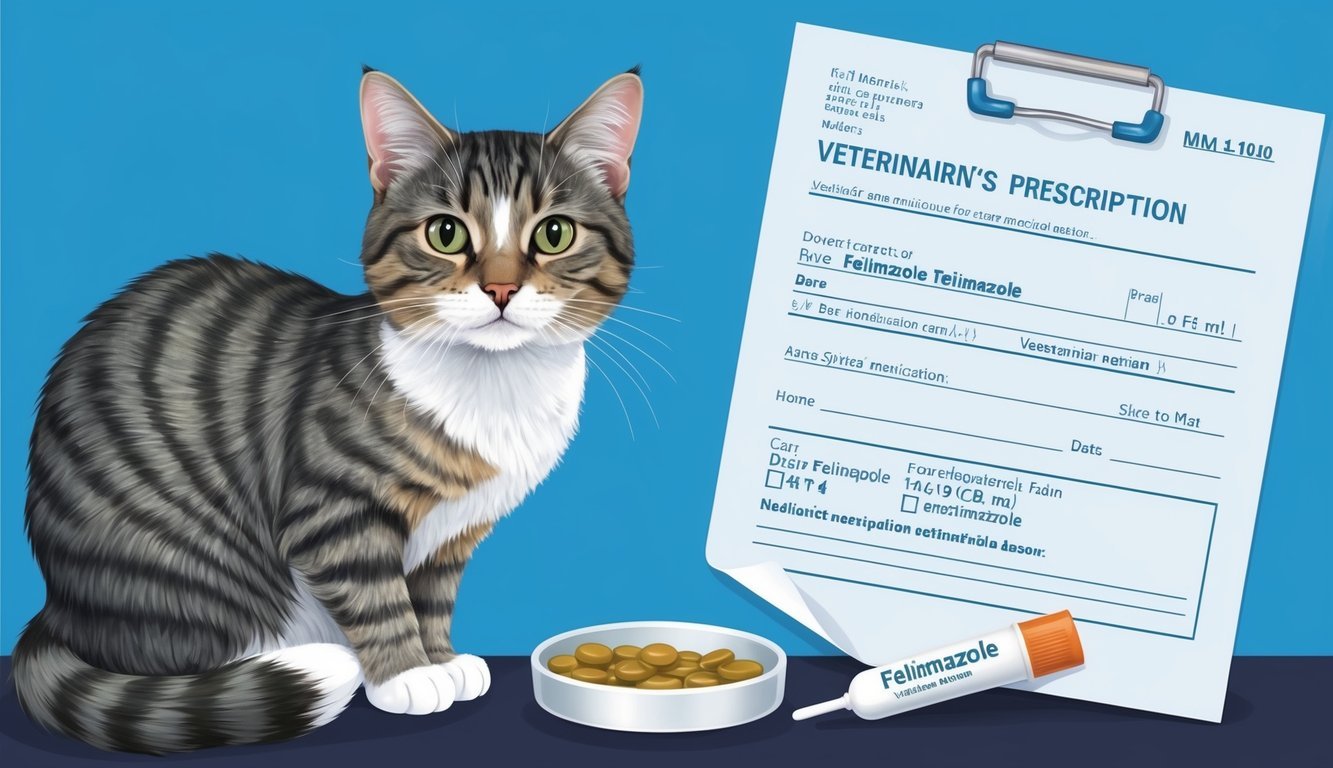
When using Felimazole for your cat, it’s crucial to understand the correct dosage and how to administer it effectively.
This medication is typically given to manage hyperthyroidism in cats, and specific dosing guidelines help ensure your pet’s safety and health.
Determining the Right Dosage
The starting dose for Felimazole is usually 2.5 mg administered every 12 hours.
This dosage may be adjusted based on your cat’s individual needs, weight, and health status.
After three weeks, your veterinarian will perform recheck lab work to assess your cat’s thyroid hormone levels.
Dosage adjustments should only be made in 2.5 mg increments.
It’s essential not to split or crush the tablets, as this can alter how the medication is absorbed.
Always follow your vet’s exact directions to achieve the best results for your cat.
Methods of Administration
Felimazole comes primarily in tablet form, but it can also be found as a transdermal gel.
You can administer the oral tablets directly into your cat’s mouth or hide them in a small amount of food to ensure your pet takes the medication.
If you’re using the transdermal gel, squeeze the prescribed amount onto your cat’s inner ear skin.
This method is particularly helpful if your cat resists taking pills.
Always wash your hands after handling the gel to avoid potential contamination.
Schedules and Missed Doses
Administer Felimazole at consistent intervals, ideally at the same time each day.
This routine helps maintain stable medication levels in your cat’s system.
If you forget a dose, give it as soon as you remember.
If it’s close to the time of the next dose, skip the missed dose and continue with the regular schedule.
Never give two doses at once, as this could lead to overdose and harmful side effects.
If you have concerns about missed doses, consult your veterinarian for guidance.
Safety and Side Effects

When considering Felimazole for your cat, it’s essential to understand its safety profile and potential side effects.
While many cats tolerate the medication well, being informed about what to watch for can help you protect your furry friend.
Common Side Effects
The most frequently reported side effects of Felimazole include:
- Vomiting
- Diarrhea
- Lethargy
- Anorexia (loss of appetite)
These symptoms can indicate how your cat is reacting to the medication.
Generally, they can be mild and may resolve without intervention.
However, persistent or severe symptoms should prompt a call to your veterinarian.
In some instances, skin reactions such as pruritus and skin lesions may occur.
While these reactions are less common, monitoring your cat’s skin and overall health is essential.
Serious Adverse Events
Though rare, some serious adverse events can arise from Felimazole use.
Monitor your cat for signs of:
- Immune-mediated anemia
- Thrombocytopenia (low platelet count)
- Liver disease signs, such as jaundice or changes in urination
Seek immediate veterinary attention if your cat shows signs of weakness, pale gums, or excessive bleeding.
These conditions require prompt treatment to prevent further complications.
Precautions and Contraindications
Before starting Felimazole, discuss your cat’s medical history with your veterinarian.
Pre-existing conditions, such as kidney disease or liver disease, can influence how your cat metabolizes the medication.
It is also critical to inform your vet if your cat is taking other medications, as drug interactions may occur.
Lastly, while Felimazole is generally considered safe, continuous monitoring during treatment is advisable, especially during the initial stages.
Monitoring and Ongoing Care
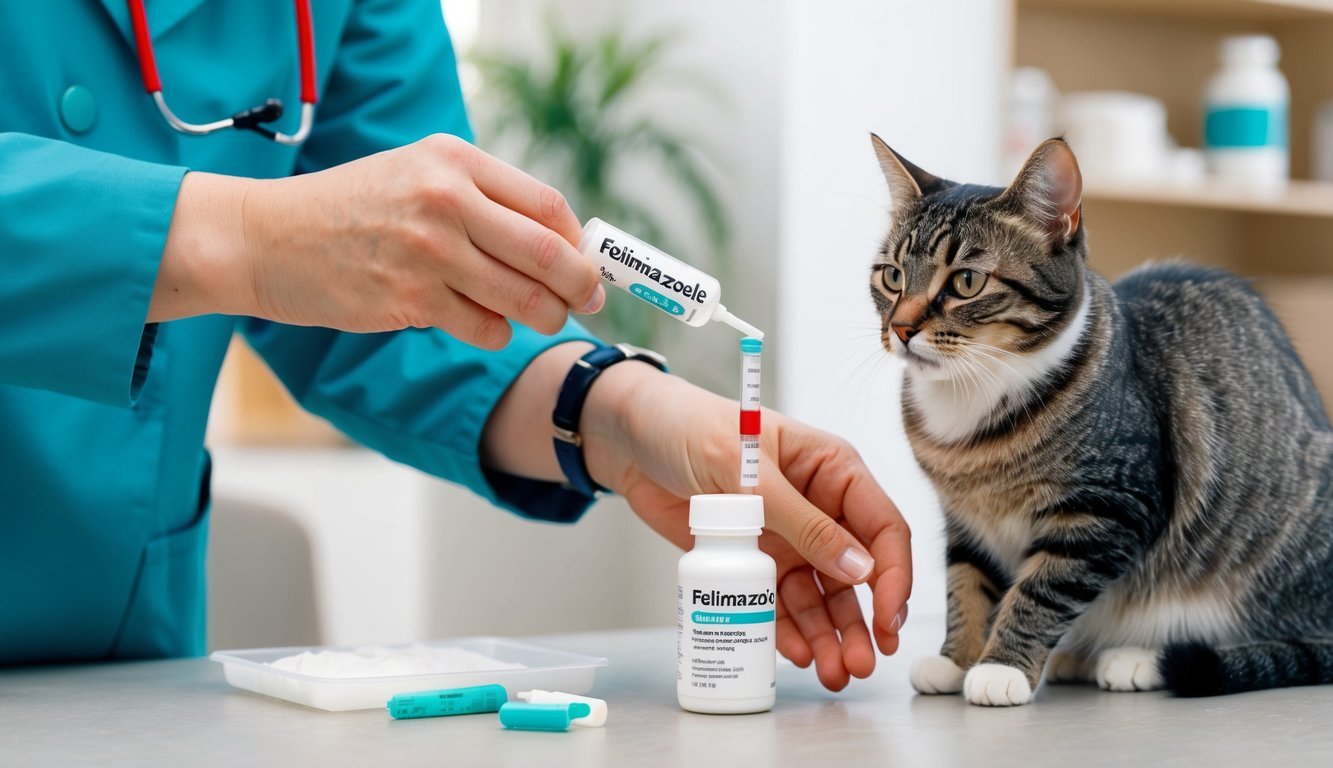
Regular monitoring and ongoing care are essential when your cat is undergoing treatment with Felimazole.
Keeping a close eye on your pet’s health will help you catch any issues early and ensure effective management of their hyperthyroidism.
Regular Veterinary Visits
Scheduling regular veterinary visits is crucial.
During these appointments, your veterinarian will evaluate your cat’s overall health and response to Felimazole.
The typical recommendation is every 3 to 6 months, but your vet may adjust this based on your cat’s condition and any side effects observed.
Discussions about changes in behavior, appetite, or energy levels are vital.
Always communicate any concerns or unusual symptoms.
These visits may include physical examinations and are an opportunity to adjust dosages if necessary.
Bloodwork and Health Checks
Bloodwork plays a critical role in monitoring your cat’s response to Felimazole.
Your vet will likely recommend blood tests every 3 to 6 months to check for any changes in blood cell counts, liver enzymes, and kidney function.
These tests help identify issues such as elevated liver enzymes or BUN (blood urea nitrogen) levels, which could indicate potential side effects or complications.
Maintaining a close watch on these parameters allows for timely adjustments to the treatment plan.
Prompt identification of any irregularities can make a significant difference in your cat’s health.
Diet and Lifestyle Management
Dietary changes may be necessary for your cat while on Felimazole.
A balanced diet can support overall health and help manage weight, especially if your cat experiences appetite changes.
Consult your veterinarian for recommendations tailored to your cat’s specific needs.
Additionally, maintaining a stable and stress-free environment is important.
Stress can exacerbate health issues.
Regular playtime and creating a comfortable space for your cat can contribute positively to their well-being.
Keeping a close eye on these aspects of care can help improve your cat’s quality of life during treatment.
Alternative Treatments and Considerations
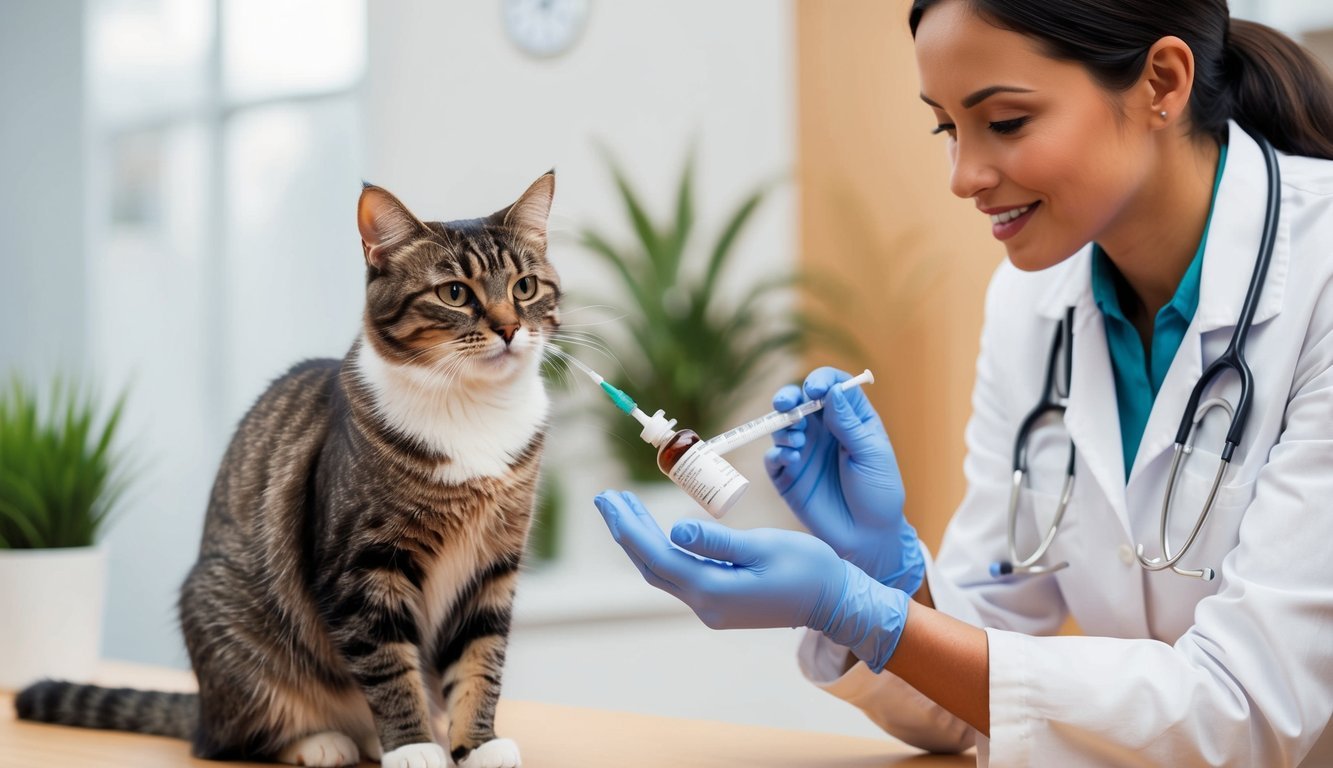
When managing feline hyperthyroidism, it’s important to explore various treatment pathways.
Not every cat will respond to Felimazole alone, so understanding alternative options can help you and your veterinarian make informed decisions.
Other Treatment Options
In addition to Felimazole, also known as Methimazole or Tapazole, there are other antithyroid drugs available.
Some veterinarians may recommend alternatives like carbimazole, which works similarly.
You might also consider dietary management.
Certain prescription diets are formulated to contain reduced iodine, impacting thyroid hormone production.
These diets can be an effective adjunct therapy, but transitioning to a new food should always be done under veterinary guidance.
Keep in mind that the choice of treatment can depend on your cat’s overall health and specific condition.
Monitoring for side effects such as lethargy or vomiting is crucial in any treatment plan.
When to Opt for Surgery or I-131
If your cat shows resistance to medication or has a severe case of hyperthyroidism, your veterinarian may recommend surgical removal of the thyroid gland.
This procedure can be curative but carries inherent risks, particularly in older cats.
Another highly effective option is radioactive iodine therapy (I-131).
This non-invasive treatment specifically targets overactive thyroid tissue, leading to long-term remission in many cases.
It often requires a special facility and sometimes might be more expensive than other treatments.
Understanding Labels and Medication Interactions
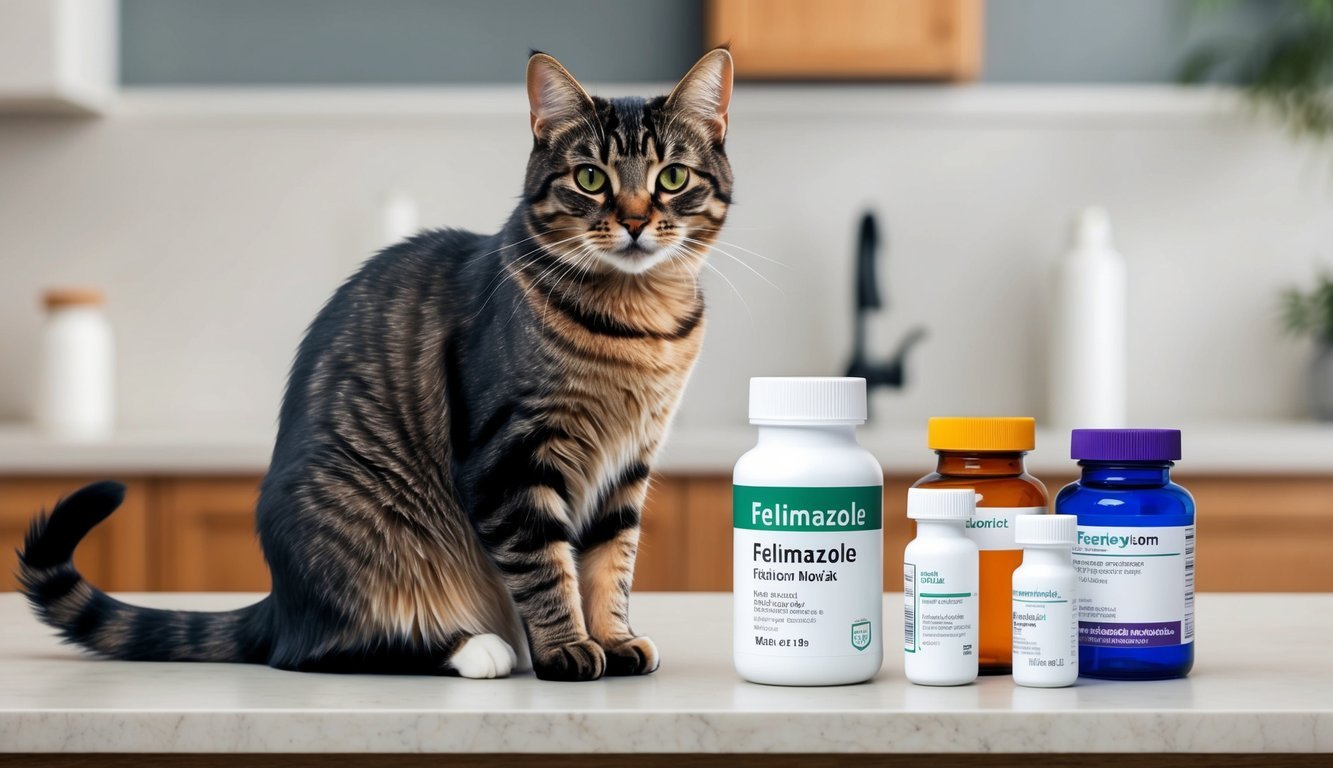
When administering Felimazole to your cat, it’s crucial to carefully interpret labels and understand potential medication interactions.
This knowledge helps ensure safe and effective treatment for hyperthyroidism.
Reading Felimazole Labels
When you look at Felimazole labels, pay attention to the dosage instructions.
The typical starting dose is 2.5 mg every 12 hours, but this can vary based on your cat’s individual needs.
Also, check for warnings and precautions.
Cats with renal dysfunction may need special evaluation.
Always verify the expiration date and store the medication as recommended.
If you have prior prescriptions, consult the label instructions closely.
This diligence helps you track your cat’s treatment effectively and avoid mishaps.
Interactions with Other Medications
Felimazole can interact with other medications your cat may be taking.
It’s essential to discuss all of your cat’s current medications with your veterinarian.
Key interactions include:
- Phenobarbital: This anticonvulsant may affect Felimazole metabolism, requiring dosage adjustments.
- Theophylline: Commonly used for respiratory issues, it can also interact with Felimazole, possibly altering its effectiveness.
If your cat is using compounded medications from a compounding pharmacy, be sure to mention this, too.
Compounded drugs can have varying absorption rates and may further complicate treatment.
Special Populations: Kittens and Senior Cats

When considering Felimazole for your cat, it’s essential to understand how age and life stage can influence treatment.
Special populations like kittens and senior cats require tailored approaches due to their unique health needs.
Felimazole in Different Life Stages
Kittens, while often less susceptible to hyperthyroidism, may have unique reactions to medications like Felimazole.
It’s crucial to consult your veterinarian before administering it to young cats.
Lactating queens should also be approached with caution.
The drug’s impact on nursing kittens is not fully understood, so obtaining veterinary guidance is important.
Senior cats are a different story.
They often face multiple health challenges, including autoimmune and endocrine diseases.
Hyperthyroidism is prevalent among geriatric felines, making the use of Felimazole common.
However, senior cats may require careful monitoring for any adverse effects, especially due to other underlying conditions.
Adjustments for Age and Health
When treating senior cats with Felimazole, adjustments may be needed based on their overall health.
Older cats may experience increased side effects, including changes in bloodwork and decreased appetite.
If your cat has existing health conditions, such as kidney disease, monitoring is essential.
Safe dosage is also key.
For instance, doses exceeding the recommended guidelines can lead to serious side effects like anorexia and inflammation.
Frequently Asked Questions
If you’re exploring the use of Felimazole for your cat’s hyperthyroidism, you likely have some questions.
Here are detailed answers to common queries about side effects, dosing, and administration methods.
What are the common side effects when giving Felimazole to cats?
Felimazole can lead to side effects such as vomiting, loss of appetite, and lethargy.
Some cats may experience more serious reactions like jaundice or liver issues.
It’s important to monitor your cat for any unusual behavior and consult your vet if side effects occur.
How should Felimazole be dosed for cats with hyperthyroidism?
Felimazole is typically given orally at a dosage prescribed by your veterinarian.
Most cats receive the medication twice a day, every 12 hours.
Your vet will determine the appropriate dosage based on your cat’s weight and health condition.
Can Felimazole tablets be crushed for easier administration to a cat?
Yes, Felimazole tablets can be crushed if your cat has difficulty swallowing them.
However, consult your veterinarian before doing so to ensure that it doesn’t affect the medication’s effectiveness.
Mixing the crushed tablet with a small amount of food can make it easier for your cat to take.
What should I do if I miss a dose of Felimazole for my cat?
If you forget to give a dose, administer it as soon as you remember.
If it’s close to the time of the next dose, skip the missed one and return to the regular schedule.
Never give your cat a double dose to make up for a missed one.
Is there a liquid form of Felimazole available for cats who dislike pills?
Yes, there is a liquid formulation of Felimazole available.
This can be a great alternative for cats that refuse to take pills.
Your vet can provide guidance on how to administer the liquid form effectively.
What dietary changes should be considered for a cat diagnosed with hyperthyroidism?
Dietary changes can help manage hyperthyroidism in cats.
Your vet may recommend a low-iodine prescription diet designed specifically for this condition.
This type of diet limits the amount of iodine your cat consumes.
Limiting iodine can help control thyroid hormone production.

